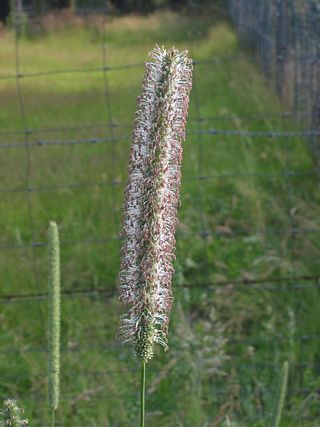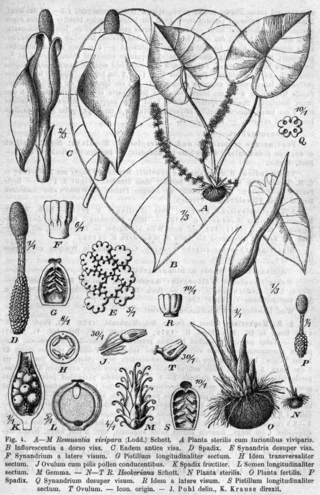
Equidae is the taxonomic family of horses and related animals, including the extant horses, asses, and zebras, and many other species known only from fossils. The family evolved around 50 million years ago from a small, multi-toed ungulate into larger, single-toed animals. All extant species are in the genus Equus, which originated in North America. Equidae belongs to the order Perissodactyla, which includes the extant tapirs and rhinoceros, and several extinct families. It is more specifically grouped within the superfamily Equoidea, the only other family being the extinct Palaeotheriidae.

Genus is a taxonomic rank above species and below family as used in the biological classification of living and fossil organisms as well as viruses. In binomial nomenclature, the genus name forms the first part of the binomial species name for each species within the genus.

Timothy is an abundant perennial grass native to most of Europe except for the Mediterranean region. It is also known as timothy-grass, meadow cat's-tail or common cat's tail. It is a member of the genus Phleum, consisting of about 15 species of annual and perennial grasses.

Juncaceae is a family of flowering plants, commonly known as the rush family. It consists of 8 genera and about 464 known species of slow-growing, rhizomatous, herbaceous monocotyledonous plants that may superficially resemble grasses and sedges. They often grow on infertile soils in a wide range of moisture conditions. The best-known and largest genus is Juncus. Most of the Juncus species grow exclusively in wetland habitats. A few rushes, such as Juncus bufonius are annuals, but most are perennials. Despite the apparent similarity, Juncaceae are not counted among the plants with the vernacular name bulrush.

Ranunculus is a large genus of about 1750 species of flowering plants in the family Ranunculaceae. Members of the genus are known as buttercups, spearworts and water crowfoots.

Rhinanthus minor, known as yellow rattle, is a herbaceous wildflower in the genus Rhinanthus in the family Orobanchaceae. It has circumpolar distribution in Europe, Russia, western Asia, and northern North America. An annual plant, yellow rattle grows up to 10–50 centimetres (3.9–19.7 in) tall, with upright stems and opposite, simple leaves. The fruit is a dry capsule, with loose, rattling seeds.

Festuca (fescue) is a genus of flowering plants belonging to the grass family Poaceae. They are evergreen or herbaceous perennial tufted grasses with a height range of 10–200 cm (4–79 in) and a cosmopolitan distribution, occurring on every continent except Antarctica. The genus is closely related to ryegrass (Lolium), and recent evidence from phylogenetic studies using DNA sequencing of plant mitochondrial DNA shows that the genus lacks monophyly. As a result, plant taxonomists have moved several species, including the forage grasses tall fescue and meadow fescue, from the genus Festuca into the genus Lolium, or alternatively into the segregate genus Schedonorus.

Nephthytis is a genus of five species of flowering plants in the family Araceae, native to tropical western and west-central Africa, ranging from Guinea to the Republic of the Congo.

Phleum is a genus of annual and perennial plants in the grass family. The genus is native to Europe, Asia and north Africa, with one species also in North and South America.

Alternaria is a genus of Deuteromycetes fungi. All species are known as major plant pathogens. They are also common allergens in humans, growing indoors and causing hay fever or hypersensitivity reactions that sometimes lead to asthma. They are present in the human mycobiome and readily cause opportunistic infections in immunocompromised people such as AIDS patients.

Sitobolium punctilobulum, the eastern hayscented fern or hay-scented fern, is a species of fern native to eastern North America, from Newfoundland west to Wisconsin and Arkansas, and south in the Appalachian Mountains to northern Alabama; it is most abundant in the east of its range, with only scattered populations in the west. It is the sole species in genus Sitobolium.
Haplolobus bintuluensis is a species of plant in the Burseraceae family. It is a tree endemic to Borneo where it is confined to Sarawak.
Pothos paiei is a species of flowering plant in the family Araceae. It is a climber endemic to the island of Borneo.
Anaphyllopsis is a genus of flowering plants in the family Araceae, native to northern South America.

Cyrtosperma is a genus of flowering plants in the family Araceae. The genus went through considerable taxonomic changes in the 1980s, and as a result is now considered to be native only to Southeast Asia and some Pacific islands. Previously, the genus was believed to be widespread from Asia to Africa and South America, but the African and South American species were subsequently moved into separate genera. Cyrtosperma is now known to be most prominent in New Guinea. The genus Cyrtosperma is unique in this regard because it is the only known big genus in Araceae that is known to be found east of Wallace's line.
Typhonium mirabile is a species of flowering plant in the family Araceae. It is found growing in Australia in eucalypts woodlands at the base of Cycas plants. It was first described in 1992 by Alistair Hay, as Lazarum mirabile and was the only species in the genus Lazarum. In 1997, Hay published a paper transferring it to the genus Typhonium.

Hadrianus is an extinct genus of tortoise belonging to the Testudinidae found in the United States, the Yolomécatl Formation of Mexico, the Alai Beds of Kyrgyzstan and Spain and believed to be the oldest true tortoise known. The genus is thought to be closely related to the genus Manouria. The genus may have evolved in the subtropics of Asia and subsequently migrated to North America and Europe. Evangelos Vlachos (2018) reassessed the North American species attributed to the genus, and determined only two as accepted namely H. corsoni & H. majusculus. The remaining species were identified as either junior synonyms, moved to other genera or considered nomen dubium do to incomplete fossils.

Acherontemys is an extinct genus of turtle from Eocene sediments in northwestern North America and comprising a single species Acherontemys heckmani. Acherontemys has been placed within the pond turtle superfamily Testudinoidea as part of the clade Pan-Emydidae.

Remusatia is a genus of flowering plants in the family Araceae. It contains 4 known species, one of which was described in 1987. This species was initially placed in genus Gonatanthus called Gonatanthus ornatus. After the genus had been sunk into Remusatia its new name was Remusatia ornatus, but it was later changed to Remusatia hookeriana.

Trionyx is a genus of softshell turtles belonging to the family Trionychidae. In the past many species in the family were classified in this genus, but today T. triunguis, the African or Nile softshell turtle, is the only extant softshell still classified as Trionyx. The other species still assigned to this genus are only known from fossils. T. triunguis is a relatively large, aquatic piscivore.















